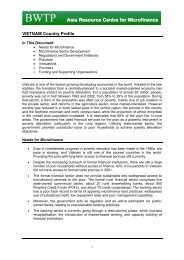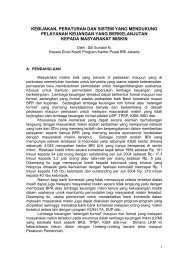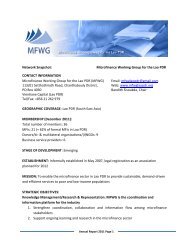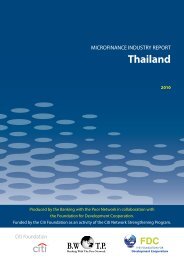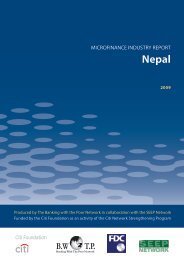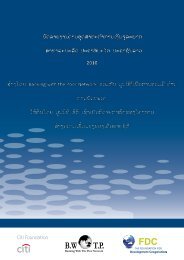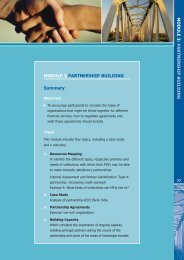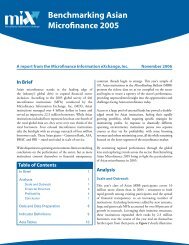Microfinance Industry Report: Indonesia - Banking with the Poor ...
Microfinance Industry Report: Indonesia - Banking with the Poor ...
Microfinance Industry Report: Indonesia - Banking with the Poor ...
Create successful ePaper yourself
Turn your PDF publications into a flip-book with our unique Google optimized e-Paper software.
3. The <strong>Banking</strong> System and <strong>Microfinance</strong><br />
As <strong>with</strong> o<strong>the</strong>r underdeveloped financial systems,<br />
commercial banks continue to dominate <strong>the</strong><br />
<strong>Indonesia</strong>n financial sector. But what is unusual<br />
about <strong>the</strong> <strong>Indonesia</strong>n case is <strong>the</strong> degree of <strong>the</strong>ir<br />
importance in <strong>the</strong> microfinance sub-sector. Bank<br />
<strong>Indonesia</strong> records about 71 million bank accounts<br />
held in 2007, of which some 69 million were deposit<br />
accounts. Total population was close to 230 million<br />
and <strong>the</strong> economically active population was <strong>the</strong>n<br />
around 108 million, suggesting far from complete<br />
access to <strong>the</strong> services of regulated financial<br />
institutions. A summary or ‘headline’ measure of<br />
access to financial services is available for <strong>Indonesia</strong><br />
and some neighbouring countries. The World<br />
Bank has produced an estimate that 40% of <strong>the</strong><br />
adult population of <strong>Indonesia</strong> has access to a bank<br />
account in a regulated banking institution (World<br />
Bank, Finance for all, 2008). This compares <strong>with</strong><br />
proportions of 59%, 29% and 26% estimated for<br />
Thailand, Vietnam and Thailand respectively, and is<br />
around <strong>the</strong> same level as <strong>the</strong> PRC (42%).<br />
<strong>Indonesia</strong> has quite a diverse banking sector, <strong>with</strong><br />
a number of institutions reflecting a distinctive<br />
history of financial sector development. Broadly<br />
speaking however, regulated banks are ei<strong>the</strong>r ‘Bank<br />
Umum’ (general commercial banks) or BPRs. The<br />
categories of regulated institutions are enumerated<br />
in table 2, which lists <strong>the</strong> varieties of commercial<br />
banks as well as <strong>the</strong> BPRs. Of 128 commercial banks,<br />
31 are government entities (ei<strong>the</strong>r 100%-owned<br />
or majority-controlled) including 26 Regional<br />
Development Banks (BPDs).<br />
An idea of <strong>the</strong>se banks’ relative importance (in<br />
terms of deposits held and loans advanced) may<br />
be gained from table 3. Overall, <strong>the</strong> data show <strong>the</strong><br />
continuing importance of <strong>the</strong> major state-owned<br />
commercial banks, which still hold about 37% of<br />
deposits and make 35% of loans, as compared <strong>with</strong><br />
42% and 43% for <strong>the</strong> private banks, respectively.<br />
The Regional Development Banks (BPDs) are also<br />
publicly-owned and, although much smaller, have<br />
<strong>the</strong> potential to play a significant developmental<br />
role at <strong>the</strong> local level.<br />
The data support <strong>the</strong> impression that <strong>the</strong> banking<br />
system was not realising its full capacity for financial<br />
intermediation, <strong>with</strong> relatively low loan-to-deposit<br />
ratios among <strong>the</strong> Regional Development Banks (51%)<br />
and state banks (72%). Private commercial banks<br />
(79%) performed somewhat more creditably. The<br />
aggregate loan to deposit ratio in <strong>the</strong> banking system<br />
had been increasing in <strong>the</strong> several years up to 2007<br />
and was at its highest level since <strong>the</strong> financial crisis of<br />
1997-98. It remains to be seen whe<strong>the</strong>r <strong>the</strong> financial<br />
crisis which commenced in 2007-08 will reverse this<br />
favourable trend and diminish <strong>the</strong> capacity of <strong>the</strong><br />
banks to finance growth and employment creation,<br />
including for micro-enterprises.<br />
An important element in <strong>the</strong> growth of lending in<br />
recent years has been <strong>the</strong> expansion of credit for <strong>the</strong><br />
officially-designated category of ‘micro-, medium- and<br />
small-enterprises’. This growth reflected regulatory<br />
changes designed to facilitate such lending, as well as<br />
government suasion and <strong>the</strong> creation of mechanisms<br />
to channel credit for approved purposes to micro- and<br />
small enterprises and low income people. However<br />
much, perhaps most, of this funding appears to<br />
benefit households in intermediate or non-poor strata<br />
of <strong>Indonesia</strong>n society.<br />
A micro-enterprise is defined by Bank <strong>Indonesia</strong>, <strong>the</strong><br />
central bank, as a sole enterprise having turnover<br />
not greater than Rp 100 million (USD 10,000). This<br />
might be thought somewhat high in a country <strong>with</strong><br />
per capita GDP of around USD 1000. Bank lending<br />
for ‘micro-, small- and medium-enterprises’ increased<br />
significantly from 2004 after <strong>the</strong> election of President<br />
Yudhoyono, averaging 20% annual growth (table 4).<br />
These credits accounted for about half of all bank<br />
credit by 2007 and totalled some USD 52 billion. This<br />
amount comprised about 40% for working capital<br />
needs, some 9% for investment purposes and 51%<br />
for consumption. Apparently <strong>the</strong> greatest element<br />
in this lending is for consumption by middle-class<br />
and non-poor families. There does not appear to be<br />
an official estimate of bank lending for microfinance,<br />
excluding <strong>the</strong> small and medium enterprise sectors.<br />
10 microfinance industry report - INDONESIA<br />
<strong>Indonesia</strong>_<strong>Report</strong>_forprint.indd 10<br />
27/05/2009 3:14:42 PM



